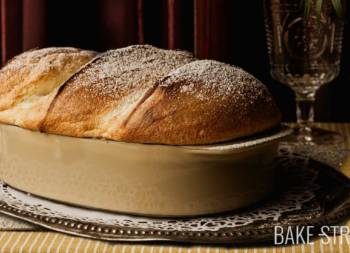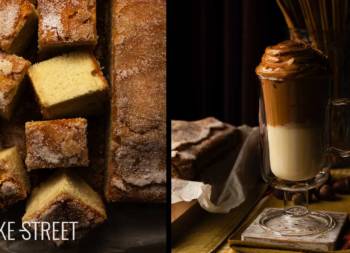
Tabatière Bread from Jura {Video recipe}
Lately I am looking for different breads that may have behind a curious story, such as the one I left you last week, look different or just catch my attention for some reason. This time I bring you this Tabatière Bread, a bread with French origin, specifically from Jura, which owes its name to its similarity to the packets of tobacco or old box of cigarettes (in French, tabatière).
This bread is really attractive thanks to the “tongue” that covers the top of the bread. Of course it becomes much more attractive if we get it to rise, curl and take a wavy form.I have developed the combination of flour for this elaboration to my choice, a basic bread recipe with wheat flour / s, sourdough (or yeast if preferred), salt and water.
There is no combination or use of any specific element to make it, in fact its particularity is its outside. We must take into account something, when we are going to make it, not to exceed its final hydration. The reasons are several, but the main one is that if the dough is very hydrated, the upper flap will stick to the itself and we won´t get a beautiful result.
I recommend you around 60-65% of final hydration, not much more because we run the risk that the final result is not expected. Another point would be how the dough would expand, if it had a lot of hydration, in the final proof.

We will make the final fermentation on a linen cloth
On this occasion we will not use a banneton to make the final proof, but we will make it on a linen cloth. It is not absolutely essential, so if you do not have it, do not discard to make it for this reason. You can always use a banneton or thick cotton cloth sprinkled with flour.
But for those who do or you have in mind to buy it, in this elaboration we will see how to make use of it. It is very simple since this cloth is the one used in bakeries to rise breads like baguettes, ciabattas… or even batards. It will be necessary to sprinkle with flour to help it not stick the dough, although the cloth alone works quite well, and place our bread over it. It will be good to place some stops at the ends to hold the dough.
In the video you can see that I cover the bread and fold the linen, but then I placed a pair of rollers to help a little more the hold.
To clean it simply, brush to remove excess flour and if there is any moisture, spread and let it dry.
The moment to transfer the bread from the linen to the board…
Yes, I know, what a complicated task! We are tired of watching it in videos but when the moment of truth, you look at the bread, the linen cloth, the board and think … how the hell did I move from one place to another without damage it? Well, finally you do it, although at least in my case, you can always do it better.
Ideally is place the board, slightly tilted, next to the bread and with a magical movement “shake” the linen, raising the bread and placing it perfectly on the board. I’m sorry to say it is not my case, but still, I can say that it did not go so badly.
I had to help myself by placing a hand under the linen to “half-lay” the bread on the cloth. It’s not the right thing, but I did not see myself able to perform that “master movement” and I was not prepared to see the bread fall to the floor … I promise to be braver the next time, hahaha.
With this maneuver, unprofessional but easy to make, we can transfer our bread without fear.
Baking tabatière bread
It is important that, please, do not forget to place the bread correctly when you transfer it in the oven. The “tongue” should be facing the oven door, which is the “coldest” part inside the underworld, so that it does not seal and favors lifting during baking.
The steam and the turn off the upper heat during the first 20 minutes, will be the following allies to get a good result.
It is a simple bread with a beautiful appearance, and everything will come out of your hands. What can give more satisfaction than this? 😉
TABATIÈRE BREAD
SOURDOUGH 100% HYDRATION:
- 6.34 oz (180 g) 100% hydration starter refreshed with 80% Shipton Mill wheat flour and 20% Shipton Mill rye flour
Here you can read how to make water yeast fruits or here how to make common sourdough (By the moment, both are only available in Spanish)
FOR THE DOUGH:
- 8.82 oz (250 g) bread flour with a bit of rye, it is a mix (I used 1878 Ylla flour)
- 9.1 oz (260 g) bread flour (I used Pani Ylla flour)
- 10 oz (285 g) water
- 0.38 oz (10,8 g) sea salt
| INGREDIENTS | BAKER´S % | SOURDOUGH | REST | TOTAL |
| Wheat Shipton Mill | 11,25% | 67,5 g | 67,5 g | |
| Rye Shipton Mill | 3,75% | 22,5 g | 22,5 g | |
| Wheat flour Pani | 43,3% | 260 g | 260 g | |
| Wheat and rye flour 1878 | 41,7% | 250 g | 250 g | |
| Salt | 1,8% | 10,8 g | 10,8 g | |
| Water | 62,5% | 90 g | 285 g | 375 g |
INSTRUCTIONS:
FIRST DAY
Make bread dough.
- In a large bowl add the flours with the water, mix with your hands until it is well hydrated and looks smooth. Cover with plastic wrap or cotton cloth and allow to make autolysis for 40 minutes.
- Add sourdough and mix in the bowl helping us with a flexible scraper.
- Transfer to a work surface, without flour, and knead. Combine kneading with resting to get almost a complete developed dough.
- Knead 2-3 minutes and let sit 5-6 minutes. Total time kneading will be roughly 10 minutes without time resting.Before the first rest, add salt, mix with your hands making sure it is completely incorporated.
- Grease with olive oil a bowl or recipient and put the dough inside. Cover and make a bulk proof for 4 hoursat room temperature. My home temperature was 70ºF. Turn and fold after 60 minutes two times.
- Let rise until dough reaches 1/3 volume.
- Refrigerate overnight. My dough was in the fridge 14 y 1/2 hours.
SECOND DAY
Remove the dough from the fridge.
- Remove the dough from the fridge and let sit for 2 hours, so it could lost low temperature. It must double size if it did not grow in the fridge.
Preshape and shape the bread.
- Preshape into a boule (ball), be careful not to degas too much, and allow to bench rest for 20 minutes cover with a cotton cloth.
- Sprinkle with rye flour the work surface and proceed to shape the tabatière bread.
- Using a roller, stretch part of the preshaped dough. Press, slightly less than 1/3 of the dough, and stretch to form a “tongue”. Make sure that there is always a bit of flour under the dough that we stretch to prevent it from adhering to the work surface.
- Stretch until double the length of bread width.
- Brush the edge with olive oil and fold the dough stretched over the bread.
- With a scraper we can finish shaping the bread before making the final proof.
- Sprinkle with flour the linen cloth and transfer the bread on it. We must turn the bread to make the final proof so that the folded part is under the bread. In this way we prevent this part proofed and inflated.
- Cover the bread with the own linen and put stops to each side to avoid that the bread widens too, we want to contain the dough and to favor that it grows.
- Let rise about 5 hours at 70ºF.
Bake the loaf
- Preheat oven 450ºF at least 30-40 minutes prior to baking with your stone or steel sheet on it positioned on final rack. Put inside a pan with volcanic stones, this helps to get steam in the baking.
- Carefully place the bread dough, which is in the linen, onto a board previously lined with baking paper. The ideal is to make a quick move to transfer the bread to the board, but in my case I helped one hand to tip it over.
- Sprinkle some rye flour on the surface and, very carefully, spread the flour over the bread to give it a uniform and clean finish.
Bake tabatière bread.
- Placee the bread in the oven, with the “tongue” facing the oven door to allow it to rise further, helping us with the board (sliding the bread on the stone or steel) and pour the boiling water over the pan with volcanic stones.Close the oven door immediately to trap the moisture.
- Bake for 20 minutes at 430ºF.
- After first 20 minutes, open the oven door to allow steam goes out, remove the track with volcanic stones with kitchen gloves and reduce oven temperature to 410ºF. Bake for 10 minutes.
- Reduce temperature to 375ºF and bake 10 minutes more. Finally bake with convection at 375ºF for 10 minutes. Bread will get a better crust this way.
- Total bake time is 50 minutes.
Ending the bake…
- Once bake has ended, turn off the oven and let sit the bread inside the oven with the door ajar for 15 minutes. Remove from the oven and let cool over a rack.
PRESERVATION: Bread can be stored for up 3-4 days cover with cotton cloth. If the beginning is dry, cut the first slice and inside will be still tender. You can cut the bread into slices, cover with plastic film and freeze. This way is the better to make perfect toast each morning. You can use the bread slice from the freezer and put into the toaster, they will be perfect 😉

TIPS TO GET A PERFECT TABATIÈRE BREAD:
- It is very important to keep in mind the flour that you are going to use since its final consistency will depend on the hydration capacity of the flour. In my case, the flour I use has a low absorption capacity. So if you notice that yours is very dry, add a little more water.
- If on the contrary, you find a very dry dough, wait to make autolysis before adding more water. The reason is that the flour takes a while to hydrate itself and show us its actual final consistency. We can sin to add more water than necessary …
- It is a bread that we will only preshape, the shaped will be the stretching of the dough and the superposition of this on the bread. Try to apply tension and give the best possible shape. Without touching in excess, of course.
- The dough we stretch to make the fold should not be too thin, but not too thick. It should be slightly less than 1/3 of the total dough.
- Olive oil helps us to rise the dough over the bread during baking.
- Remember that the “dough tongue” on the bread should make the final proof upside down to prevent that dough rises too, the result would not be so aesthetic.
- If you do not have linen cloth, you can use a round/large banneton or a thick cotton cloth.
- Try not to make a short final proof to get a beautiful oven spring like a “rocker fringe”. This will rise when the bread grows and with the help of heat and steam. Do not sacrifice a good crumb for this.

Enjoy…
This tabatière bread is very grateful as well as beauty. The heaviest part is to control the final proof at room temperature, but it is not difficult at all. Do not be afraid about it.
When you slice the bread will inevitably break. But you can enjoy as a cracker dipped in hummus, cream cheese … Of course I have to say that I want you to get involved with it and tell me how was everything! Either by mail or social networks. In Instagram you can tag me so I will not miss anything that you do 😉
Happy weekend!
Big hugs,
Eva



